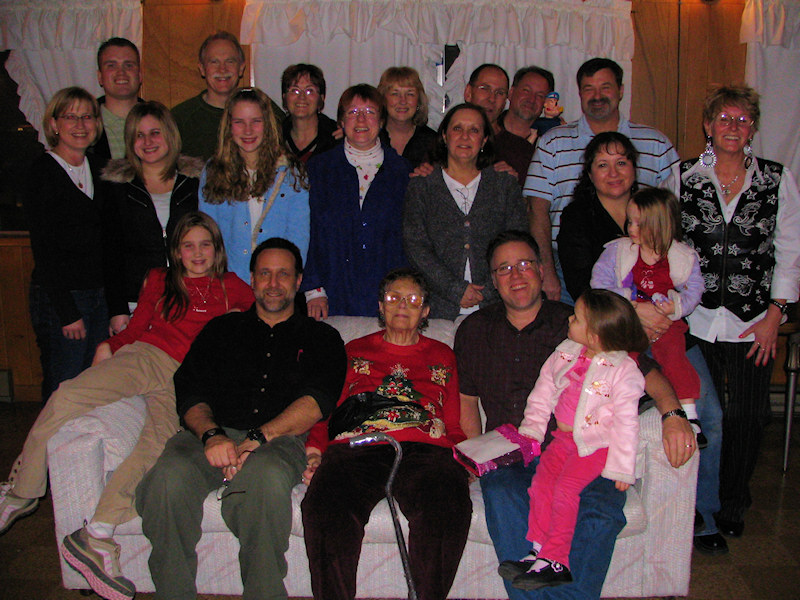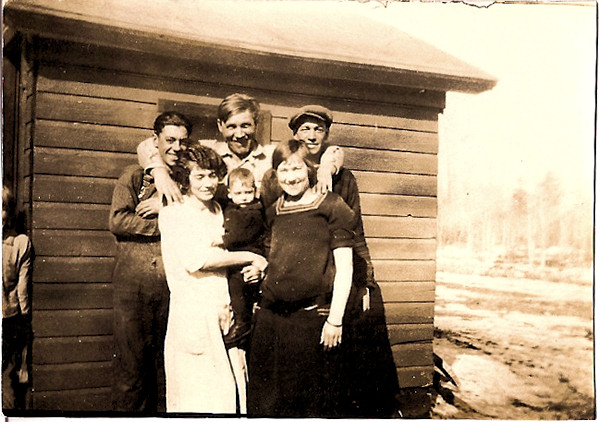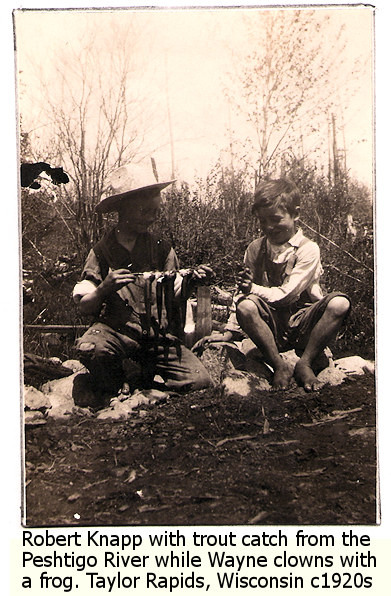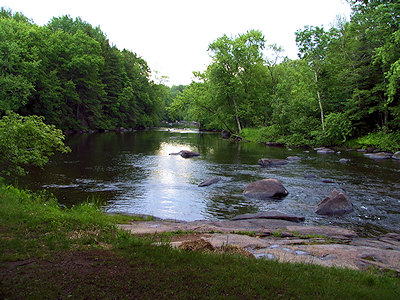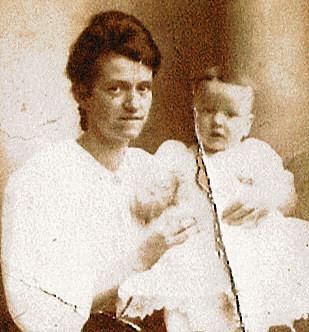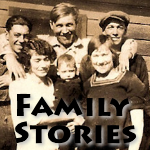
This is another childhood story by Robert F. Knapp (1913-1994), telling about his first time he and his brother, Wayne Knapp, chewed tobacco. The Clemmens/Clemens family of Kentucky are mentioned. The story takes place in July of 1925 near Taylor Rapids in Northern Wisconsin, just south of Goodman, Wisconsin, in Marinette County, near the end of the logging camp era.
It was during school vacation, somewhere in the middle of July about 1925. I was probably twelve years old at the time. About that time of the year, Wisconsin’s wild strawberries are ripening. My young brother Wayne and I were out horse hunting. It was time to cultivate the patch of corn we had. At that time we owned a horse cultivator and we needed a horse to pull it. Our horses were all running loose during the summer. When the old plow horse Jim was needed, it was the young kids job to hunt him up.
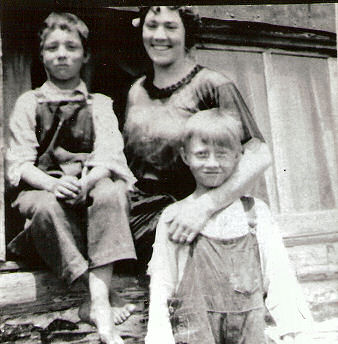 The day was very hot. We had looked through most of the familiar stomping grounds, but the horses were not to be found. On our way home we took a short cut which led through a big patch of wild strawberries. As we neared the place we heard voices. We soon came upon a family of Kentuckians picking berries. They were new folks to us. They had moved into a small shack down the road from where we lived.
The day was very hot. We had looked through most of the familiar stomping grounds, but the horses were not to be found. On our way home we took a short cut which led through a big patch of wild strawberries. As we neared the place we heard voices. We soon came upon a family of Kentuckians picking berries. They were new folks to us. They had moved into a small shack down the road from where we lived.
We recognized that they were the Clemens family. They had just come from Kentucky a short time before. We had heard a lot about them, but little was actually known for sure. What we heard was nice enough, for Kentuckians.
From among the berries, I was really shocked to see the old lady spit a large quantity of brown slimy tobacco juice out before she spoke, “Wol naw looky here boys, we’uns has got compny!” Then she grinned showing tobacco stained teeth.
Curious, I said, “Hello, are you chewing tobacco?”
Her answer came quickly, surprising me. “Lord-a-mercy youngun, ain’t you ever seed a womern chawin’ baccer afar?”
“No ma’am! I thought just old men and bad kids chewed tobacco!”
“I been chawin’ baccer since I was a three year ole. Hit ain’t never bothered me none. Here! You can try a thaw off uh my plug.”
She reached into a dirty old apron pocket and pulled out a thing that looked more like something a dog had done in the dirt than anything I’d want to put in my mouth. As much as I was curious about it, this was just disgusting.
“Oh, my, no. Our Mother would whale the devil out of us if we were to chew tobacco. Ain’t that the truth, Wayne?”
Wayne agreed saying, “Ma caught us smoking corn silks a few weeks back and my back end still quivers when I think about it. I don’t know what she’d do about us chewing tobacco!”
One of the other kids who had been picking berries came over and joined his Mother. She said, “Here, Willie. Show these younguns how you kin chaw baccer.”
Then she bit off a hunk of that awful looking stuff and gave it to Willie. The little fellow couldn’t have been more than six years of age. He just took the chunk, looking so small standing there in his dirty and torn pants held up by a worn set of suspenders over his dirt stained bare shoulders. He wallered it around in his mouth for a while, then squirt much like his Mother had done a while back.
Wayne and I watched closely, expecting to see the little guy pitch his cookies and whatever else he had in his stomach. To our amazement the little fellow never as much as batted an eye. “Hits a mite stronger than the last chaw you give me Maw, but that din’t mean I din’t like it!” Shrugging, Willie went back to his berry picking.
We live far from civilization, so I asked her where she got the tobacco, and she said, “Lord-a mercy youngun, back thar in Kintucky we grow the stuff. I twisted this baccer myself!” She gave us another serious look over and said, “Wall, if you fellers are sceered to try my baccer, I gotta be gittin’ back to my berry pickin’!”
I didn’t like being called a coward, so I couldn’t help myself. As she turned away I spoke to Wayne, “Will you try it if I do?”
After much thought, Wayne replied very slowly, “I’ll try it if you do, but you gotta go first!”
“Okay, ma’am, we’ll try a small chew of your tobacco, but you gotta promise you won’t tell our Mother!”
The old lady turned back to us with a wicked grin showing more teeth missing than in. “I ain’t no tattle-tale, boy. Besides I ain’t never seed yer Maw. Well, put this in yer mouth and see how long you kin go without spittin’!”
I looked the awful stuff over pretty well before I stuck it in my mouth. It was quite sweet, and tasted better than it looked, I’m certain of that. Wayne also took a small chew, but I think he spit his out right away. I just kept chewing as the old lady left to go back to her work, and then spit it out, making a bit of mess, as Wayne and I started toward home.
I didn’t get very far till I began to get terribly dizzy. The hot sun didn’t help any either. Then I got sick. I’d spit the rotten stuff out, but I must have gotten some down my throat. I fell down on the ground, the whole world was rolling around me. I grabbed huge handfuls of grass to keep from falling off the world!!
I was unable to stand and actually pulled the grass out by the roots trying to keep from rolling around. I’d never felt anything like it in my life. I had been made sick once before from eating too much corn on the cob, but it was nothing like this. I wished were dead! I finally vomited, getting rid the tobacco and everything else I’d eaten for the past several hours. That helped.
The dizziness seemed to let up a little, and I managed to stagger to my feet. I was in terrible shape. It was a feeling that I would never want to repeat. We finally made it home, where I stopped at the creek and washed out my mouth as good as I could. It was a long time before I tried chewing tobacco again!

 The day was very hot. We had looked through most of the familiar stomping grounds, but the horses were not to be found. On our way home we took a short cut which led through a big patch of wild strawberries. As we neared the place we heard voices. We soon came upon a family of Kentuckians picking berries. They were new folks to us. They had moved into a small shack down the road from where we lived.
The day was very hot. We had looked through most of the familiar stomping grounds, but the horses were not to be found. On our way home we took a short cut which led through a big patch of wild strawberries. As we neared the place we heard voices. We soon came upon a family of Kentuckians picking berries. They were new folks to us. They had moved into a small shack down the road from where we lived.